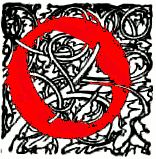[An abstract of a presentation delivered at the July 1995 Symposium in Sante Fe, New Mexico, on the occasion of the world premiere of David Lang and Manuela Holterhof's opera about Ruskin, Modern Painters.]
 ne of the most compelling questions asked of James McNeill Whistler at the infamous Whistler-Ruskin trial was how long it took the painter to complete one of his nocturnes for which he charged 200 guineas, a comparatively large sum. Asked if it only took him a few hours to paint a nocturne, Whistler responded that it took him a lifetime. The question and response are emblematic of one of the most debated subjects in the art press, in popular artists' biographies and memoirs, and in the marketplace — the economic value of an artist's labor.
ne of the most compelling questions asked of James McNeill Whistler at the infamous Whistler-Ruskin trial was how long it took the painter to complete one of his nocturnes for which he charged 200 guineas, a comparatively large sum. Asked if it only took him a few hours to paint a nocturne, Whistler responded that it took him a lifetime. The question and response are emblematic of one of the most debated subjects in the art press, in popular artists' biographies and memoirs, and in the marketplace — the economic value of an artist's labor.
John Ruskin's "A Joy Forever" (1857; reprinted in 1880; in vol. 16 of Cook and Wedderburn) examines the value of artists' labor through the topics of genius, art education, art collecting private and state patronage, and art's accessibility to the public. The essay is the result of two lectures given in Manchester to celebrate the 1857 Manchester Exhibition. That Ruskin could write a political economy of art reflects a Victorian belief that art making was a public labor, not a purely private enterprise. Ruskin believes the state, modeled on the patriarchal householder, must find and train geniuses, giving them a gentleman's education and an apprentice's workshop experience.
Ruskin's essay is filled with lively and often inconsistent arguments. Ruskin vacillates between pricing artists' labor only for the hours spent on individual works, while arguing for rewarding them for their economically immeasurable quality of genius. Ruskin wants living artists' works collected by private collectors while public museums collect only works by dead artists. He believes investment motivates collectors, but he denies the surplus value of art works over time to the very artists who produce the works. Ruskin admonishes his audience to preserve past art, especially Italian, and secondly to encourage production of art by living artists. However, he utterly fails to explain how to determine a fair price for art, past or present, at a time when England as a nation was actively trying to purchase both Italian and English art to establish its national cultural authority.
Despite inconsistencies Ruskin consistently argues for the domination of the artist by the patron. Prices are to be kept low by paying for production time only or by purchasing cheaper works by young rather than established, artists. Ruskin treats collecting as a charitable act; for him consumption is the exercise of moral virtue ( a very medieval idea!). Ruskin considers artists to be children, denies them a role in determining their works' monetary value, and distrusts their egos and desire for autonomy. He believes the buyer purchases the labor and the laborer/artist, as well as the product. Ruskin advocates a patriarchal employer who subjects artists to constant supervision and who is omnipotent: the patron determines the artist's training and the work's price, value, subject matter, and even medium.
Ruskin's refusal to acknowledge the professional autonomy of artists is characteristic of wider Victorian anxieties about art production, genius, the solitary studio, and the economic value of artists' labor. By 1880 when his essay was reprinted, however, Victorian artists vigorously resisted Ruskin's notions of them as childlike and incapable of comprehending and determining their work's economic value and their own social role. In defense, they took it upon themselves to define create new organizations and dominate exhibition venues in a burst of professional activity from 1880 to 1914.
Last modified 28 October 2023